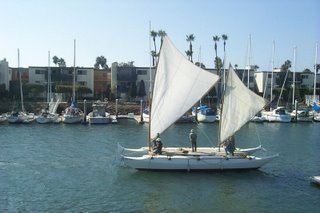In the article entitled "The New Age of Sail" by Dmitry Orlov, the author makes a case for the sailboat as mankind's greatest invention and explores the possibilities of the simple sailing vessel's role in the future as a vehicle and lifestyle of choice. Here's a quote from his accessment of the modern yacht style of sailboat, in his section The Sorry State of Sail:
"None of the sailboats currently in commercial production will do at all. Since the end of the age of sail, sailing has been relegated to a number of niches, none of them of much practical value. Overall, they have become a luxury item. An important element of this luxury is the freedom from the buzz or throb of the engine, the stench of fuel, and the noxious fumes of the exhaust plume: freedom to enjoy nature without assaulting it. An early application of steam power was in powering sailboats out of doldrums, but steam sailboats were quickly supplanted by steamboats that did not carry sail. A similar fate awaits the many modern sailboats that are designed to rely on their diesel or gasoline auxiliaries, but for the exact opposite reason: they will be trapped in the permanent doldrums of fuel scarcity.
The particular applications still reserved for sail include recreation, sport, and historical preservation, with dollops of luxury thrown in for each one. Recreational vessels range from small sailing canoes and dinghies to daysailers and small coastal cruisers. Sport encompasses a wide variety of racing boats, which are designed for speed, especially speed to windward. Historical preservation includes various old sloops and schooners, as well as newer boats constructed entirely of wood by master craftsmen. The realm of pure luxury gives us an assortment of cabin cruisers, which often have plenty of teak and mahogany paneling and trim, fancy navigational electronics, on demand hot water, and a sound system. Although they are capable of crossing oceans, they are mainly used for ostentation, to motor around the harbor, and to throw dockside parties. "
He goes on to further examine the simple requirements for living and traveling on the sea as in this excerpt from A Reasonable Set of Requirements:
The author goes on to describe his idea of the perfect boat to fit these requirements, basically the sharpie type and in particular some of the works of naval architect Phil Bolger. I am also an admirer of the sharpie type, especially some of the Parker designs, and I have built two dinghies designed by Phil Bolger and have sailed quite a bit on one of his open sharpie daysailor designs built by my brother. But to me the one limitation of most sharpie designs is ultimate, ocean crossing seaworthieness, and most sharpie designers state that their boats are designed for coastal and protected waters rather than long bluewater passages.
Needless to say, Wharram catamarans, built of wood with simple tools and basic skills, and a design incorporating maximum seaworthieness based on proven design principles also fit the author's requirements, though he might not be aware of them. Anyone interested in building and sailing their own boat will enjoy reading the entire article here:
http://www.culturechange.org/cms/index.php?option=com_content&task=view&id=67&Itemid=1


